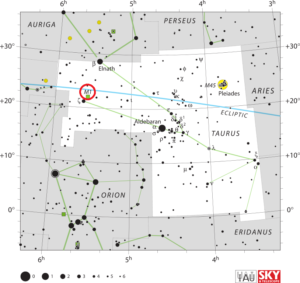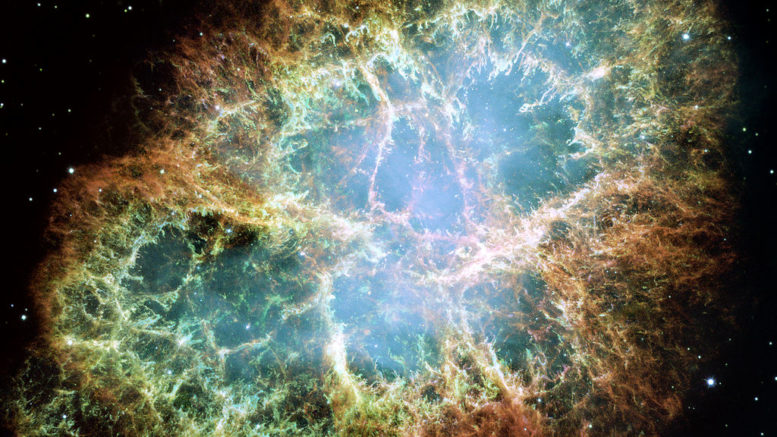This review of Messier 1 is to provide details about the observational history of the Crab Nebula, details about how to find it in the sky, what the object could look like in your scope, and potential astrophotography options if available.
Overview
| Description | |
| Visible From Pacific Northwest | September To February |
| Best Time To Observe | January |
| Minimum Size Of Viewing Device | Small Telescope |
| Object Type | Nebula Supernova Remnant |
| Designations | Messier 1, M1, Crab Nebula, NGC 1952, Sharpless 244, LBN 833, 3C 144 |
| Right Ascension | 05h 34m 32s |
| Declination | +22d 00m 52s |
| Constellation | Taurus |
| Absolute magnitude | -3.1 |
| Apparent magnitude | +8.4 |
| Apparent dimensions | 420″ × 290” (6×4 arc minutes) |
| Object Radius | 5.5 light years (1.7 parsecs) |
| Distance From Earth | 6,500 light years |
History
The Crab Nebula is a supernova remnant in the constellation of Taurus. Astronomers have been able to use their findings and such to become the first astronomical object identified to correspond to a historical supernova explosion. The Crab Nebula is said to have been first seen as a bright supernova recorded by Chinese astronomers in 1054. It is said that after the supernova occurred, the Crab Nebula was visible for 23 straight days during the daytime.
Modern observation of the Crab Nebula began in 1731 by English astronomer John Bevis who observed the nebula.
Charles Messier discovered the nebula independently on August 28, 1758. It would be on September. 12th, 1758 that Messier would make this object the first object in his Messier Catalogue. It is worth noting that Messier 1, the Crab Nebula, is the only supernova remnant listed in Messier’s catalogue and the most famous supernova remnant object in the night sky.
The common name comes from William Parsons, 3rd Earl of Rosse, who observed the object in 1840 using a 36-inch telescope and produced a drawing that looked somewhat like a crab.
The first photograph of M1 was taken by Dr. Isaac Roberts in December 1892 using a 20-inch telescope.
A rapidly spinning neutron star was discovered to be embedded in the center of the Crab Nebula. This neutron star has a pulsar orbiting it, called the Crab Pulsar, which orbits every 133 days. The Crab Pulsar is believed to be 17-19 miles in diameter, emitting radiation pulses every 33 milliseconds. These pulses range from radio wave to x-ray signals.
Locating M1 In The Sky
Finding Messier 1, the Crab Nebula can be done by starting in the Taurus Constellation. Once inside the Taurus constellation, finding Messier 1 can be done after the observer has found Zeta Tauri because the Crab Nebula is 1 degree Northwest of Zeta Tauri. Zeta Tauri can be found by identifying Aldebaran, the brightest star in Taurus, and following the line of the V-shape that Aldebaran is part of, to Zeta Tauri.
It is worth noting that Messier 1 is situated only 1.5 degrees from the ecliptic, which means that are frequent conjunctions and occasional transits of planets, and occultations by the Moon.

Viewing M1
With an apparent magnitude of 8.4 the Crab Nebula will be visible to binoculars in clear and dark sky conditions, but not to the naked eye. Sky quality is crucial to finding M1 as bright sky conditions make it harder to find the Crab Nebula. Here is a table showing the viewing instrument and the corresponding detail.
| Viewing Object | Object Detail (Good Conditions Assumed) |
| Binoculars | Tiny, Hazy Patch |
| Smaller Telescopes (4, 6, 8 inches) | Some detail In Shape, Similar ToComet. Without A Tail |
| 16 inch Telescopes Or Larger | Crab Nebula Filaments and Structure |
Photographing M1
Although a smaller target as compared to other celestial targets, it is possible not necessarily the easiest to photography as a beginner. Nevertheless, the bar to entry to photograph the M1 Crab Nebula can be. done with both DSLRs and more advanced astrophotography cameras.
The website galactic-hunter below has a great detail about the process ass this can provide some starting information for users as they were helpful in finding this information. But for a DSLR, one can have an exposure time of anywhere around 2-4 hours, with a modern DSLR for 3 minute exposures with shots using an ISO 800. A golden formula is that to get all the photos required, for 4 photos taken, 2 should be light photos, 1 dark photo, and 1 bias photo.
For the CMOS camera, the only difference between the DSLR and a more advanced camera would be to shorten exposure times to somewhere around 2 minutes, a gain of 139, and the use of HA, SII, and OIII filters for 20 minutes of imaging each.
Sources And Further Reading
Descriptions of all of Messier Objects will be able to found here.
These sources below are amazing places to gather information about Messier 1: The Crab Nebula.
https://www.galactic-hunter.com/post/m1-the-crab-nebula
https://www.nasa.gov/feature/goddard/2017/messier-1-the-crab-nebula

Be the first to comment on "Messier 1: Crab Nebula"